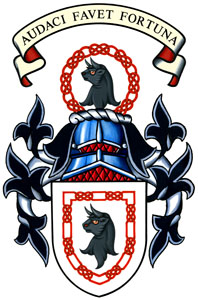 The ruins of tall craggy towers and castles are still scattered along the Scottish/English border, home to this notable surname Turnbull. Their ancient history is closely woven into the rich fabric of the border chronicles.
The ruins of tall craggy towers and castles are still scattered along the Scottish/English border, home to this notable surname Turnbull. Their ancient history is closely woven into the rich fabric of the border chronicles.
Diligent research amongst some of the most ancient manuscripts such as the Exchequer Rolls of Scotland, the Inquisitio, the Ragman Rolls, the Domsday Book, baptismals, parish records, and tax records and cartularies researchers found the first record of the name Turnbull in Roxburghshire where they were seated from early times and their first records appeared on the early census rolls taken by the early kings of Scotland to determine the rate of taxation of their subjects.
The name, Turnbull, occurred in many references, and from time to time, it was spelt Turnbull, Turnball, Trimble, Trimbell, Trumbell, Trumbill, Turnbul, Turnbell, and others. Scribes and church officials spelt the name as it sounded, and frequently the spelling changed even during the person's own lifetime.
The Turnbulls are believed to be descended from the Boernicians an ancient, founding race of the English/Scottish border dating from about the year 400 A.D. The border was also home to Clans such as the Sturdy Armstrongs, the Gallant Grahams, the Saucy Scotts, the Angry Kerrs, the Bells, the Nixons, the Famous Dicksons, the Bold Rutherfords, and the Pudding Somervilles.
From these war-like clans of the border the surname Turnbull was found In Roxburgh where they were recorded as a family of great antiquity seated on the lands of Rule in the parish of Hobkirk in that shire, through which flowed the River Rule. Alan Rule and Richard Rule were father and son first Chiefs of the Clan in 1214 and 1249, and Adam and Thomas Rule both rendered homage to King Edward I of England on brief the conquest of Scotland in 1296.
The Rules became allies of the Kerrs of Etterick. Traditionally one branch of the Rules were the scions of the Turnbull family when he saved King Robert the Bruce at Stirling Park from a charging bull by turning the bull's head. The King commanded the Rule to change his name to Turnbull and granted him the lands of Bedrule. The same Rule believed to be Walter de Rule was the Scottish Champion at the Battle of Halidon Hill in 1333 when he advanced with a huge black dog and challenged any Englishman to fight him. He was killed by Sir Robert Venal of Norfolk.
The Turnbulls became a notorious Clan on the border. Their seat was at Bedrule Castle twenty miles due east of Berwick in Roxburghshire. William Turnbull was Lord Privy Seal of Scotland in 1447. The Clan were constantly at feud with the Armstrongs and it Is said that the Turnbulls could put 500 men Into the saddle for one of their forays. Frequently clan members used the names Trimble, Trimbell and Turnbol. Notable amongst the family name during the early history was Sir Walter Rule (Turnbull), Scottish Champion.
Clan feuds became so intense that in 1246 A.D., 6 Chiefs from the Scottish side and 6 from the English side met at Carlisle and created a set of laws acceptable to the border territory and its people. These were unlike any laws prevailing in England or Scotland or, for that matter, anywhere else in the world. For refusal of assistance when called a person could be hanged on the instant, without a trial. While clans were on this 'hot trod' to recover stolen property, (from which we get the modern expression ‘hot to trot'), they were protected from almost all eventualities.
When the crowns of England and Scotland were united under James VI of Scotland In 1603 the Border Clans were dispersed to England, northern Scotland and to Ireland. Some ware banished directly to the Colonies.
In Ireland, they were granted lands previously held by the Catholic Irish. They signed an ‘Undertaking' to remain protestant and faithful to the Crown. In Ireland they settled in county Donegal under the name Rule, In Antrim under the name Trimble. and in Ulster under the name Turnbull.
The New World beckoned and the many settlers in Ireland, known as the Scotch/Irish, became disenchanted. They sailed aboard the armada of sailing ships known as the ‘White Sails' which plied the stormy Atlantic. Some called them, less romantically, the 'coffin ships'. Amongst the first pioneers who could be considered kinsmen of the family name Turnbull, of that same Clan or family, was Thomas and William Turnbull settled in New Jersey in 1685; John Turnbull settled in Anapolis, Maryland in 1753;William Turnbull settled in Bonavista, Newfoundland in 1765; William settled in St John’s in Newfoundland in 1794.
 These pioneers became the nucleous of the first settlements from Maine to the Cumberland Gap, from Nova Scotia to the Prairies.
These pioneers became the nucleous of the first settlements from Maine to the Cumberland Gap, from Nova Scotia to the Prairies.
The family name Turnbull provided many prominent contemporaries, Professor Alex Turnbull, Gynaecologist; The Ven. John Turnbull; Reginald Turnbull, Chairman, Turnbull Scott Shipping; Sir Richard Turnbull; Sir Winton Turnbull, Australian politician.
The most ancient grant of a Coat of Arms was researched as:
Three black bull’s heads on a silver background.
The Crest is a Black bull’s head.
The ancient family motto for this distinguished name was; “I saved the King”.
